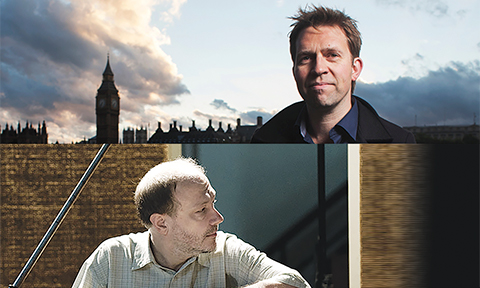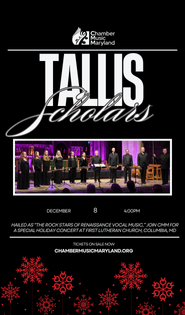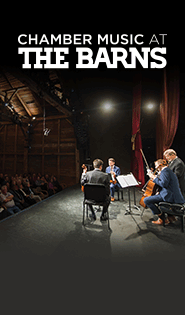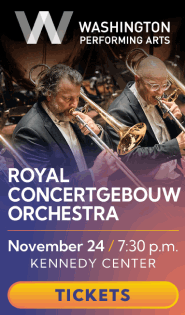Riotous Stravinsky from Andsnes and Hamelin in duo recital

Leif Ove Andsnes and Marc-André Hamelin performed a duo piano recital Monday night at Strathmore for Washington Performing Arts.
Back in the day, this undergraduate piano major most enjoyed playing music for two pianos or piano, four hands. It is a special collaboration, rather like coordinating two separate orchestral ensembles, and the range of sounds and colors is multiplied 100 percent.
Even star pianists succumb to the duet bug, as Leif Ove Andsnes and Marc-André Hamelin showed Monday night for a concert presented by Washington Performing Arts. The stage of the Music Center at Strathmore had just two large Steinways back to back, but the sonic effect seemed larger than the sum of its parts.
Music in this genre is often a family affair. Mozart grew up playing keyboard, four hands, with his sister, Nannerl, and his father. Later he composed his famous Sonata for Two Pianos in D Major to play with one of his students, Josepha Barbara Auernhammer. She may have also been the intended performer for the less-known Larghetto and Allegro in E-flat for Two Pianos heard here, composed around 1781, when she began to study with the composer.
Andsnes took the primo parts in the first half, with an exquisite touch on the opening phrases. Only in this work did a few misalignments occur, mostly in the slow opening section, while the Allegro portion was fast and thrilling. The piece is in a fragmented form, copied and completed by Abbé Maximilian Stadler (the version printed in the Neue Mozart-Ausgabe). This duo played the more sparkly adaptation by pianist Paul Badura-Skoda, and Hamelin especially added further embellishments on repeated sections.
The highlight of the program was Stravinsky’s Concerto per due pianoforti soli, completed in 1935 and from the same neoclassical period as the Symphony of Psalms. Stravinsky played the piece with his son, Soulima, on one of the special double grand pianos made by the Pleyel company, which Stravinsky had used for the performances of Les noces a decade earlier. Andsnes and Hamelin easily negotiated the work’s thorny passages, creating a sultry, jazz-infused mood in the “Notturno” movement and leaping with balletic grace across the keyboard in the active opening movement and the concluding “Preludio e fuga.”
Debussy composed En blanc et noir, a suite for two pianos, in 1915, part of an efflorescence of chamber music produced in his final years. The composer said that the piece’s movements “derive their color and feeling merely from the sonority of the piano.” Andsnes and Hamelin coordinated the many tempo alterations and collective color tableaus in the first movement (“Avec emportement”) with consummate skill.
The second movement especially was delicate and elegiac, the quotation of the choral Ein feste Burg and the bugle-like calls a tribute to the composer’s friend Jacques Charlot, killed in the First World War. The third movement, dedicated to Stravinsky, provided not only an exciting conclusion to the first half but a connection to the Stravinsky pieces that surrounded it.
After intermission was the main course of the evening, a riotous yet obsessively precise performance of Stravinsky’s own arrangement of The Rite of Spring. The performers chose to play this four-hands arrangement on two keyboards, which eliminated much of the choreography needed to pull it off seated at the same piano. Hamelin now took the primo part, setting the tone for a percussive, almost manic interpretation—the collective outburst of clashing sounds in the “Cortège du sage” was shocking.
On the secondo part Andsnes brought subtlety to the “Spring Rounds” dance in Part I. Although one occasionally missed some of the remarkable orchestral colors, enigmatic readings like that of the “Mystic Circles of the Young Girls” gave this version its own mysterious flavors.
Applause that was far too tame elicited only a single encore, Stravinsky’s hilariously grotesque Circus Polka: For a Young Elephant, composed for a ballet in which George Balanchine choreographed the elephants of the Ringling Brothers & Barnum & Bailey Circus. According to the New York reviews, they had at least two other Stravinsky encores left in the tank.
Washington Performing Arts presents The English Concert in a performance of Handel’s opera Ariodante, with Harry Bicket conducting a cast led by Joyce DiDonato, 8 p.m. tonight in the Kennedy Center Concert Hall. washingtonperformingarts.org; 202-785-9727.





Posted May 03, 2017 at 9:18 am by Laura Youens
How exciting this concert must have been! I, too, was a piano major in undergraduate school, and often played 2-piano or duet works with my twin sister. However, we never played that Rite of Spring arrangement!